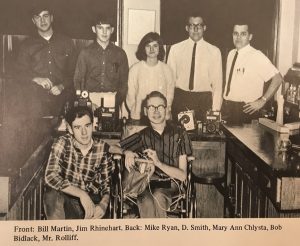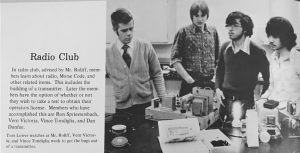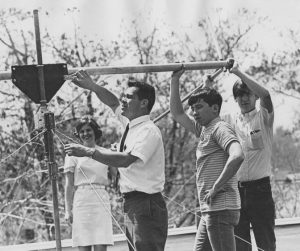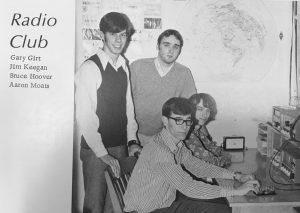The curriculum for the physics class I taught at Ravenna High School involved some electronics. The first year I taught the course I found two boys in this class that knew more electronics than I did – much more. On further investigation I found that they both possessed amateur (ham) radio licenses and had studied electronics in order to pass the required license exams. Getting an amateur radio license looked like fun and a way to obtain some valuable knowledge. Otch, the chemistry teacher, was also interested, so we did some investigating. At that time the requirements for a Novice Class license were a basic knowledge of electronics, FCC rules, and the ability to send and receive Morse code at the rate of 5 words per minute. After a few weeks of study and practice we went downtown and talked to “Pete”, the proprietor of the local TV repair shop. He had a “ham” license and also was qualified to administer the license exam. After we passed the test and obtained our licenses we built radio stations in our homes and put them on the air. We had a lot of fun doing this and as we became more proficient with the code and technical knowledge, we both advanced through the program to obtain higher class licenses. I ended up with an Amateur Extra Class license which I still hold (WA8TPO). This license required code proficiency of 25 or more words per minute and knowledge of advanced electronics.
I thought that this might be a good way to stimulate student interest in electronics so I started a radio club at the school and had several students join. We built a small station from WWII surplus parts and located it in a corner of the physics/chemistry lab. We ran a lead-in wire through a window which then connected to a long-wire antenna on the school roof.This was strictly a CW (code only) station and any student who wanted to get on the air had to learn Morse code and pass the license exam.

Our first radio station. Notice the transmitter and receiver taken from a WWII fighter plane
One of the nice things about being young is the speed at which they learn a new language such as Morse code. Otch and I had to”sweat bullets” to learn it but these kids picked it up so quickly that I HATED THEM ALL!!
Since I now had an Extra-Class license I was qualified to administer the amateur radio license exam. As a result we had several licensed students in the high school before a year had gone by. They spent their spare time on the air talking to other hams around the US and Canada, comparing notes, and becoming more code-proficient. Some of them obtained General-Class licenses before graduating.

Transmitter built from old TV parts
Now the club members wanted a more powerful station so they could talk to hams around the world. We ran some fund raisers and obtained enough money to buy a better transmitter from the Heathkit company. This was excellent equipment, but was not assembled. All you get is a bag of parts with instructions on how to build and trouble-shoot the transmitter. That was good because the students could participate in the construction and testing. I obtained an excellent surplus receiver and other equipment from the Military Affiliate Radio System (MARS), and converted it to the amateur bands (I will write about “MARS” in a future article).
We also obtained some aluminum tubing from Montigney’s hardware store with which we built a 15 meter directional antenna. We mounted it on a TV rotor and put it on the school roof.

Maryann Chlysta, Gene Roliff, Roger Tsai, Carl Danford
Assembling the 15 meter beam antenna
The Science Department had recently moved into a new building and our new radio station was now located in a small room adjacent to the new physics lab. This room had no windows, so in order to hook up an antenna we needed to go through the roof. I got out my trusty drill and drilled a 1/2 inch hole through Ravenna High School’s shiny brand new roof, inserted an L-shaped piece of conduit with a metal plate through it, ran a coaxial line through the conduit, and sealed it up with tar so it wouldn’t leak.
It would be an under-statement to say that the principal was not happy with me when he saw what I had done to his new roof. He told me that before I did something that radical to his new building, I needed to fill out a work order in triplicate and present it to him. He would then take it to the school board and eventually they would bring it up for consideration at some future meeting.
I knew all that. I also knew that the board would table the work order for at least 3 months before acting on it. If they approved, it would then take the same amount of time for the custodian to get off his butt to do the job, and in 6 months or so we might have an antenna connection. During that period of time the students had already contacted over 50 countries from around the world.

New Station
To me this appeared to be a perfect example of where it is better to ask for forgiveness than permission.